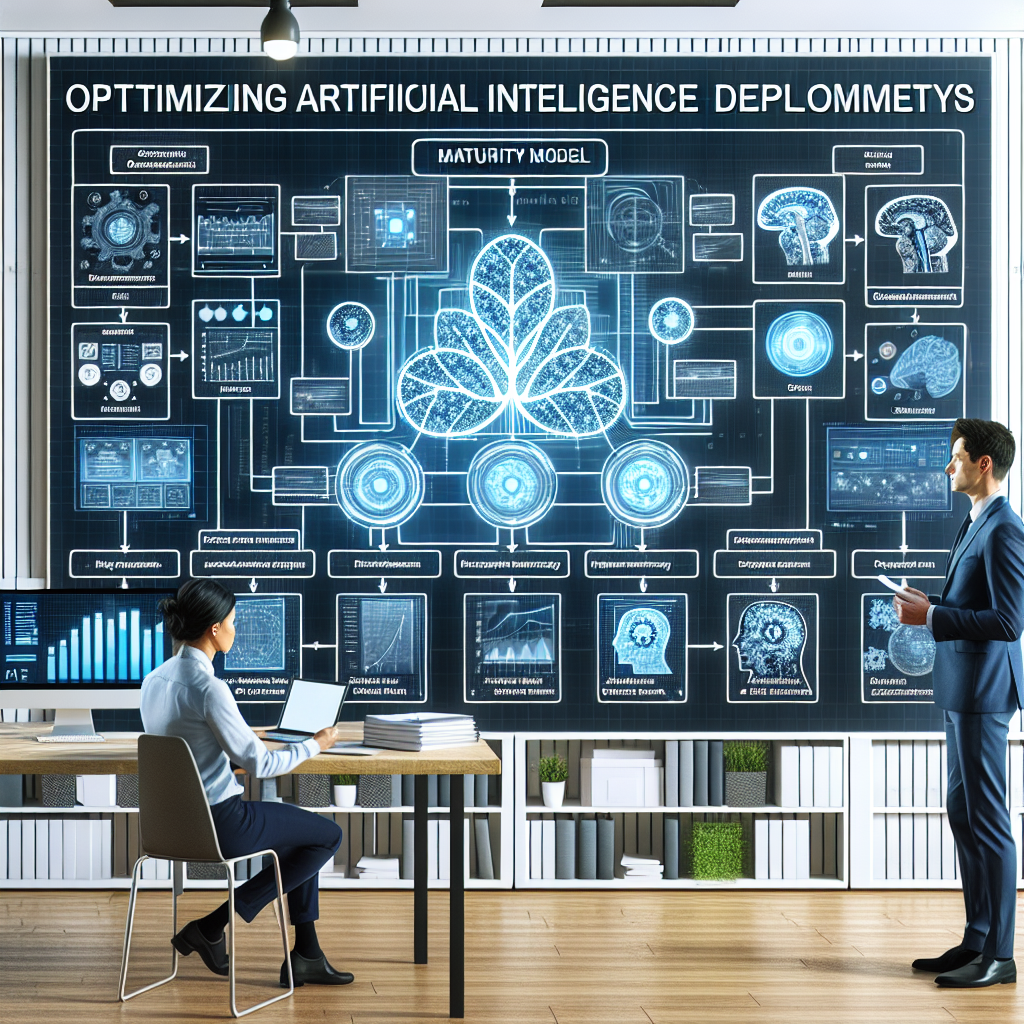HIMSS Analytics Introduces Maturity Model for Optimizing AI Deployments

In the rapidly evolving landscape of healthcare technology, the integration of artificial intelligence (AI) has emerged as a transformative force. Recognizing the need for a structured approach to AI deployment, HIMSS Analytics has introduced a Maturity Model designed to optimize AI implementations in healthcare settings. This article delves into the intricacies of this model, exploring its components, benefits, and real-world applications. Through detailed analysis and case studies, we aim to provide a comprehensive understanding of how this model can revolutionize AI deployment in healthcare.
Understanding the HIMSS Analytics Maturity Model
The HIMSS Analytics Maturity Model is a framework that guides healthcare organizations in effectively deploying AI technologies. It provides a structured pathway for organizations to assess their current AI capabilities, identify areas for improvement, and strategically plan for future advancements. This section explores the key components of the model and how it facilitates a systematic approach to AI integration.
Components of the Maturity Model
The HIMSS Analytics Maturity Model is built on several core components that collectively guide organizations through the AI deployment process. These components include:
- Assessment: A comprehensive evaluation of an organization’s current AI capabilities, including infrastructure, data management, and workforce readiness.
- Roadmap Development: A strategic plan outlining the steps needed to advance AI maturity, including technology investments, training programs, and process improvements.
- Implementation: The execution of the roadmap, involving the deployment of AI technologies, integration with existing systems, and continuous monitoring of progress.
- Optimization: Ongoing refinement of AI deployments to enhance performance, efficiency, and outcomes.
- Evaluation: Regular assessment of AI initiatives to measure success, identify challenges, and inform future strategies.
Each component is designed to ensure that AI deployments are aligned with organizational goals, resources, and capabilities, ultimately leading to more effective and sustainable implementations.
Benefits of the Maturity Model
The HIMSS Analytics Maturity Model offers numerous benefits to healthcare organizations seeking to optimize their AI deployments. These benefits include:
- Structured Approach: The model provides a clear and systematic framework for AI deployment, reducing the risk of ad-hoc implementations and ensuring alignment with organizational objectives.
- Improved Outcomes: By guiding organizations through a comprehensive assessment and optimization process, the model helps to maximize the impact of AI technologies on patient care and operational efficiency.
- Resource Optimization: The model assists organizations in identifying and prioritizing resource allocation, ensuring that investments in AI are strategically targeted and yield the greatest return.
- Scalability: The maturity model supports scalable AI deployments, enabling organizations to expand their AI capabilities as they progress through the maturity stages.
- Enhanced Collaboration: By fostering a shared understanding of AI goals and strategies, the model promotes collaboration across departments and stakeholders, facilitating more cohesive and effective implementations.
These benefits underscore the value of the HIMSS Analytics Maturity Model as a tool for optimizing AI deployments in healthcare settings.
Case Studies: Successful AI Deployments
To illustrate the practical application of the HIMSS Analytics Maturity Model, we examine several case studies of healthcare organizations that have successfully leveraged the model to optimize their AI deployments.
Case Study 1: Hospital A
Hospital A, a large academic medical center, utilized the HIMSS Analytics Maturity Model to enhance its AI capabilities in radiology. By conducting a thorough assessment of its existing infrastructure and workforce readiness, the hospital identified key areas for improvement, including data integration and staff training. Through the development and implementation of a strategic roadmap, Hospital A successfully deployed AI algorithms for image analysis, resulting in improved diagnostic accuracy and reduced turnaround times.
Case Study 2: Health System B
Health System B, a regional healthcare network, applied the maturity model to optimize its AI-driven predictive analytics for patient care management. By following the model’s structured approach, the health system was able to integrate AI technologies with its electronic health record (EHR) system, enabling real-time risk stratification and personalized care interventions. This led to significant improvements in patient outcomes and operational efficiency.
These case studies demonstrate the tangible benefits of the HIMSS Analytics Maturity Model in guiding successful AI deployments in diverse healthcare settings.
Challenges and Considerations in AI Deployment
While the HIMSS Analytics Maturity Model provides a valuable framework for optimizing AI deployments, healthcare organizations must also navigate a range of challenges and considerations. This section explores some of the key obstacles and factors that organizations must address to ensure successful AI integration.
Data Management and Integration
Effective data management and integration are critical to the success of AI deployments. Healthcare organizations must ensure that their data is accurate, complete, and accessible to AI systems. This involves addressing challenges such as:
- Data Silos: Many healthcare organizations operate with fragmented data systems, leading to data silos that hinder AI integration. Overcoming these silos requires robust data governance and interoperability solutions.
- Data Quality: AI systems rely on high-quality data to generate accurate insights. Organizations must implement data validation and cleansing processes to ensure data integrity.
- Data Security and Privacy: Protecting patient data is paramount in healthcare. Organizations must implement stringent security measures and comply with regulations such as HIPAA to safeguard sensitive information.
Addressing these data-related challenges is essential for maximizing the effectiveness of AI deployments in healthcare.
Workforce Readiness and Training
The successful integration of AI technologies requires a workforce that is equipped with the necessary skills and knowledge. Healthcare organizations must invest in training and development programs to prepare their staff for AI adoption. Key considerations include:
- Skill Development: Organizations must provide training programs to enhance the technical skills of their workforce, including data analysis, machine learning, and AI system management.
- Change Management: AI deployments often require changes in workflows and processes. Organizations must implement change management strategies to facilitate smooth transitions and minimize resistance.
- Collaboration and Communication: Effective communication and collaboration between IT, clinical, and administrative teams are essential for successful AI integration. Organizations should foster a culture of collaboration and shared understanding.
By prioritizing workforce readiness and training, healthcare organizations can ensure that their staff is well-prepared to leverage AI technologies effectively.
Ethical and Regulatory Considerations
The deployment of AI in healthcare raises important ethical and regulatory considerations. Organizations must navigate these complexities to ensure responsible and compliant AI implementations. Key considerations include:
- Bias and Fairness: AI systems can inadvertently perpetuate biases present in training data. Organizations must implement measures to identify and mitigate bias, ensuring fair and equitable outcomes.
- Transparency and Explainability: Healthcare organizations must ensure that AI systems are transparent and explainable, enabling clinicians and patients to understand how decisions are made.
- Regulatory Compliance: Organizations must comply with relevant regulations and standards, such as the FDA’s guidelines for AI in medical devices, to ensure the safety and efficacy of AI deployments.
By addressing these ethical and regulatory considerations, healthcare organizations can build trust and confidence in their AI initiatives.
Future Trends in AI Deployment in Healthcare
The HIMSS Analytics Maturity Model provides a foundation for optimizing AI deployments, but the landscape of AI in healthcare continues to evolve. This section explores emerging trends and future directions in AI deployment, offering insights into how organizations can stay ahead of the curve.
Advancements in AI Technologies
AI technologies are rapidly advancing, offering new opportunities for healthcare organizations to enhance their capabilities. Key advancements include:
- Natural Language Processing (NLP): NLP technologies are improving the ability of AI systems to understand and interpret human language, enabling more effective analysis of unstructured data such as clinical notes and patient feedback.
- Computer Vision: Advances in computer vision are enhancing the ability of AI systems to analyze medical images, leading to improved diagnostic accuracy and efficiency in fields such as radiology and pathology.
- Reinforcement Learning: Reinforcement learning techniques are enabling AI systems to learn from interactions with their environment, offering new possibilities for personalized medicine and adaptive treatment strategies.
These advancements are driving the next wave of AI innovation in healthcare, offering new opportunities for organizations to enhance patient care and operational efficiency.
Integration with Emerging Technologies
The integration of AI with other emerging technologies is creating new possibilities for healthcare organizations. Key areas of integration include:
- Internet of Things (IoT): The combination of AI and IoT technologies is enabling real-time monitoring and analysis of patient data, facilitating proactive care interventions and improved patient outcomes.
- Blockchain: The integration of AI with blockchain technology is enhancing data security and interoperability, enabling secure and transparent sharing of patient information across healthcare networks.
- Telemedicine: AI-powered telemedicine solutions are improving access to care and enabling remote diagnosis and treatment, particularly in underserved and rural areas.
By leveraging these emerging technologies, healthcare organizations can unlock new opportunities for innovation and transformation.
Personalized Medicine and Precision Health
AI is playing a pivotal role in advancing personalized medicine and precision health, offering new possibilities for tailored treatment strategies and improved patient outcomes. Key developments include:
- Genomic Analysis: AI technologies are enabling more efficient analysis of genomic data, facilitating the identification of genetic markers and personalized treatment plans.
- Predictive Analytics: AI-powered predictive analytics are enabling more accurate risk stratification and early intervention, improving patient outcomes and reducing healthcare costs.
- Patient Engagement: AI-driven patient engagement solutions are empowering patients to take an active role in their care, improving adherence to treatment plans and overall health outcomes.
These developments are driving the shift towards more personalized and patient-centered care, offering new opportunities for healthcare organizations to enhance their services.
Conclusion: The Path Forward for AI in Healthcare
The HIMSS Analytics Maturity Model provides a valuable framework for optimizing AI deployments in healthcare, offering a structured approach to assessment, planning, implementation, and optimization. By leveraging this model, healthcare organizations can enhance their AI capabilities, improve patient outcomes, and drive operational efficiency.
However, successful AI deployment requires more than just a framework. Organizations must also address key challenges related to data management, workforce readiness, and ethical considerations. By navigating these complexities and staying abreast of emerging trends, healthcare organizations can unlock the full potential of AI technologies and drive meaningful transformation in the industry.
As AI continues to evolve, the HIMSS Analytics Maturity Model will play a crucial role in guiding organizations on their journey towards AI maturity, ensuring that they are well-equipped to harness the power of AI for the benefit of patients and healthcare systems alike.





